
|
|
Für die deutsche Fassung bitte nach unten scrollen
|
|
Enjoy Ancient Art from the Comfort
of Your Home
|
|
|
|
Since the gallery is closed let us deliver ancient art with this newsletter straight into your home. We proudly present twelve masterpieces – from Egypt, the Roman Empire, Etruria, Greece and the Orient. Travel with us around the world and into the past. The gilded sarcophagus mask from the Ptolemaic period originates from Cleopatra's time, the wonderful basalt naophorus is an additional half a millennium older. The terracotta head of Humbaba kept evil away from our ancestors in Babylonia in the early 2nd millennium B.C. And the marble Roman republican looks at us with dignity and pride even after 2,000 years.
|
|
Should one of our objects inspire you, do not hesitate to call us at +43 664 1168 324, or write us an email info@cb-gallery.com. We are also available anytime for video calls and are delighted to process and answer your requests. Please be also assured that worldwide shipment with DHL Express and FedEx Priority is still working perfectly well.
|
But most of all we are looking forward to seeing you in person again!
|
|
|
|
Our Highlight of the Month:
|
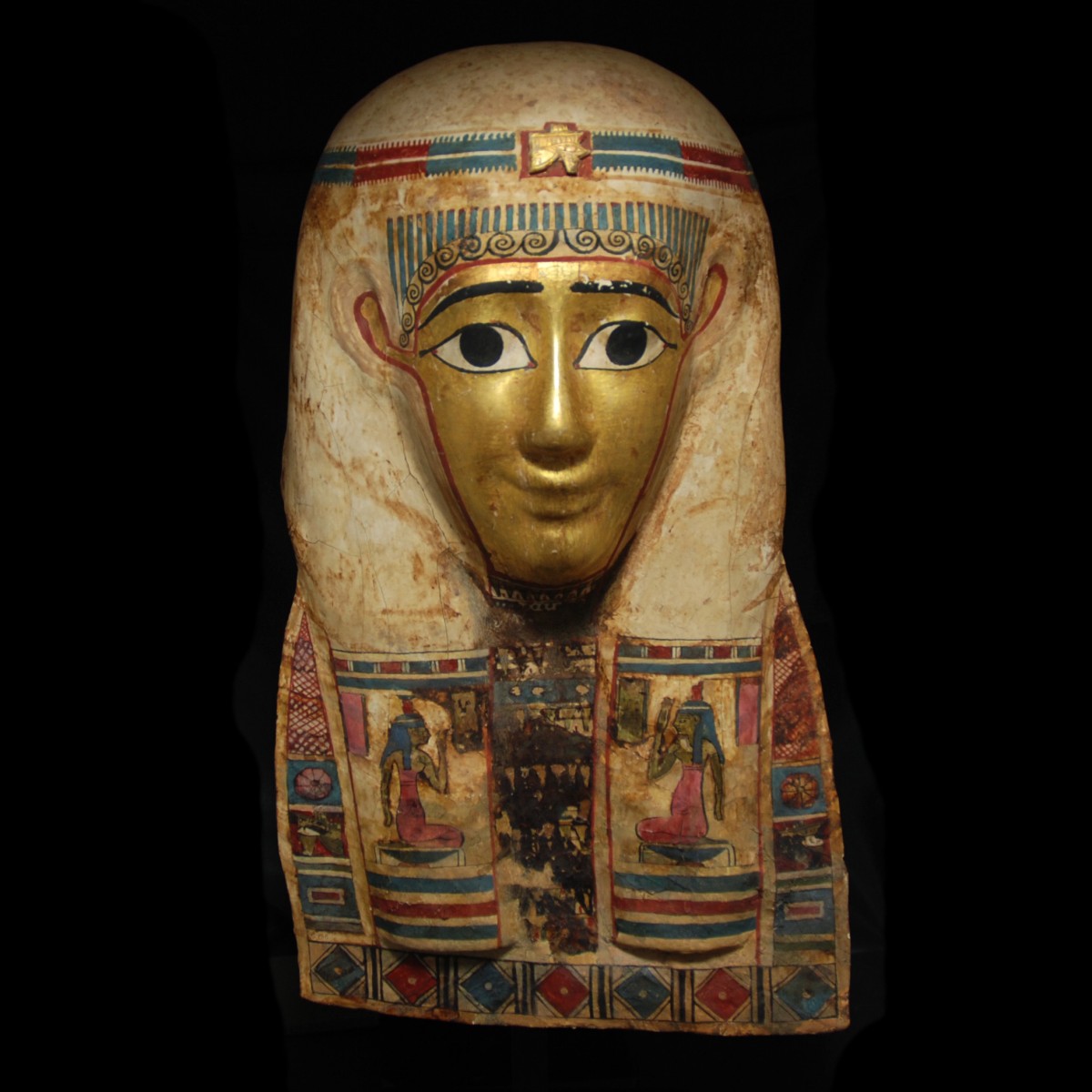
|
|
|
|
|
|
Egypt – Late Ptolemaic Period, 1st century B.C.
|
Mummy mask with rich gold leaf decoration symbolizing the golden flesh of the gods, which, identical to the sun, promises immortality. The mask with a tripartite wig and a red and blue headband that is tied at the back. A golden udjat eye on his forehead. Under the diadem blue strands fall over the forehead ending in black ringlets. The face is dominated by large eyes with wide open, dark pupils that are typical for the masks from this period. Black raised eyebrows. Mouth and nose carefully worked out. The golden face is framed by a red line. Goddesses kneeling on the wig lappets in adoration gesture. The Usekh collar with richly embellished, polychrome decoration. The mask is decorated with a band of geometric motifs at the bottom, and rosettes and Horus eyes form the end of the mask. On the back a standing female figure to the right with a tripartite wig and a tied diadem. Remains of bitumen. Mounted.
|
Provenance: Belgian private collection, acquired from the Galerie des Saints-Pères in Paris in April 1980. With a copy of the original certificate. Sotheby's New York on 12 December 2013, lot 18. Thence Sotheby's Hong Kong on 2 April 2018, lot 3047. Last in the Chenel collection, France. Accompanied by a copy of the French antiquities passport.
Dimensions: 46.5 cm high
Price: 28 000 Euro
|
|
|
|
Selected Artworks of the Month:
|
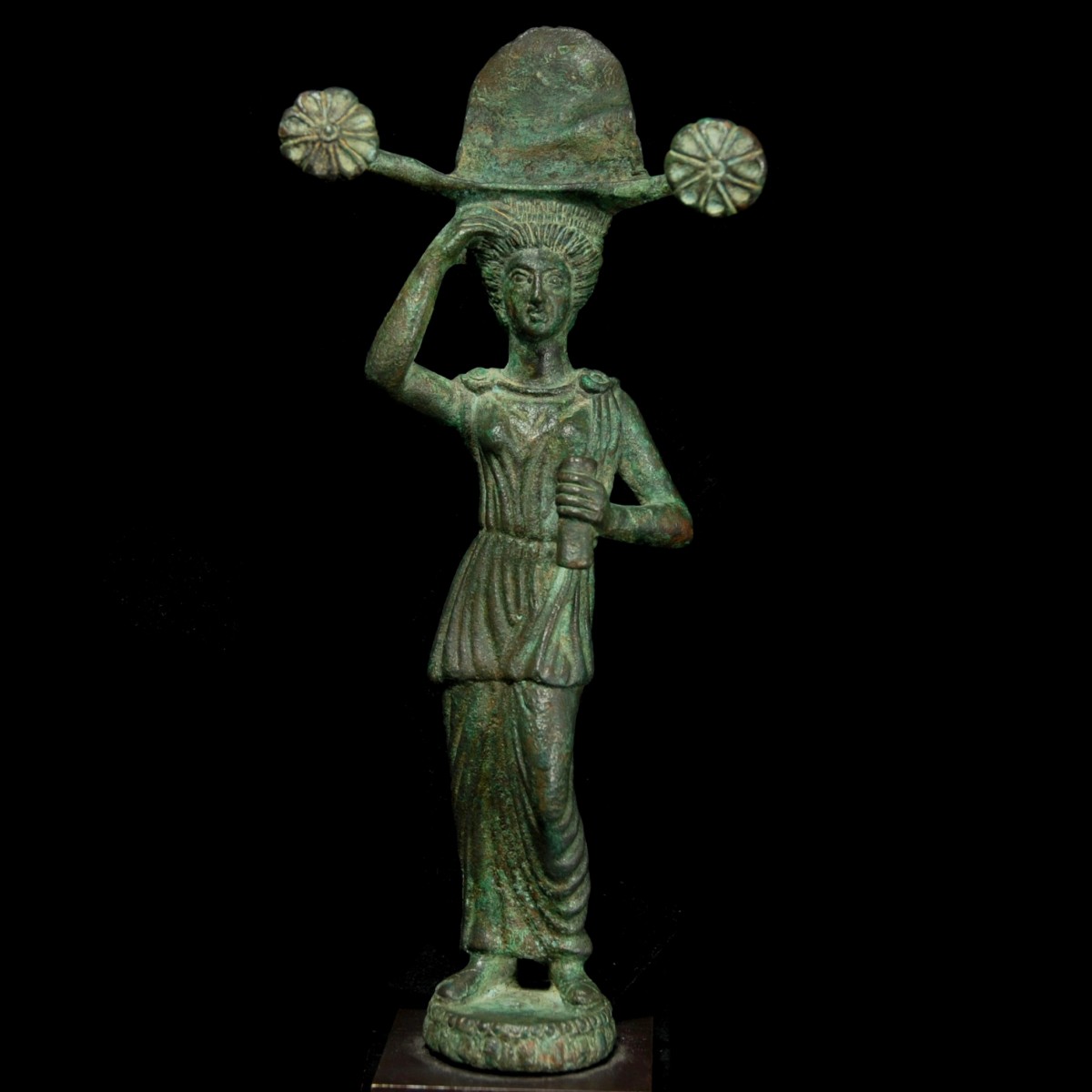
|
|
|
|
|
Magnificent solid bronze depiction of a standing goddess in a long, pleated peplos. She stands with her weight on her right leg and the left one is slightly bent forward. The peplos with a long cover is pinned by two brooches on the shoulders. The goddess, possibly one of the rare representations of a clothed Lasa (companion of the goddess of love Turan), holds a large alabastron in her left hand. The right one leads her to her lavishly piled hair, on which sits a bronze attachment. This attachment shows the face of a Gorgon on the reverse and was fixed on a patera. The two rosettes on the left and right above the head of the goddess formed the opposite end. The statuette stands on its round original base, which is decorated on the outside with a dot and tongue pattern. See for the type of an unclothed Lasa with similar posture, base and alabastron the example in the J. Paul Getty Museum with the object number 96.AC.34. Mounted.
|
Provenance: Belgian collection van der Aa, acquired from a Dutch collection, 1960s. Thence Hirsch auction Munich 2016. Last in the New York art market.
Dimensions: 18.5 cm high
Price: 22 000 Euro
|
|
|
|

|
|
|
|
|
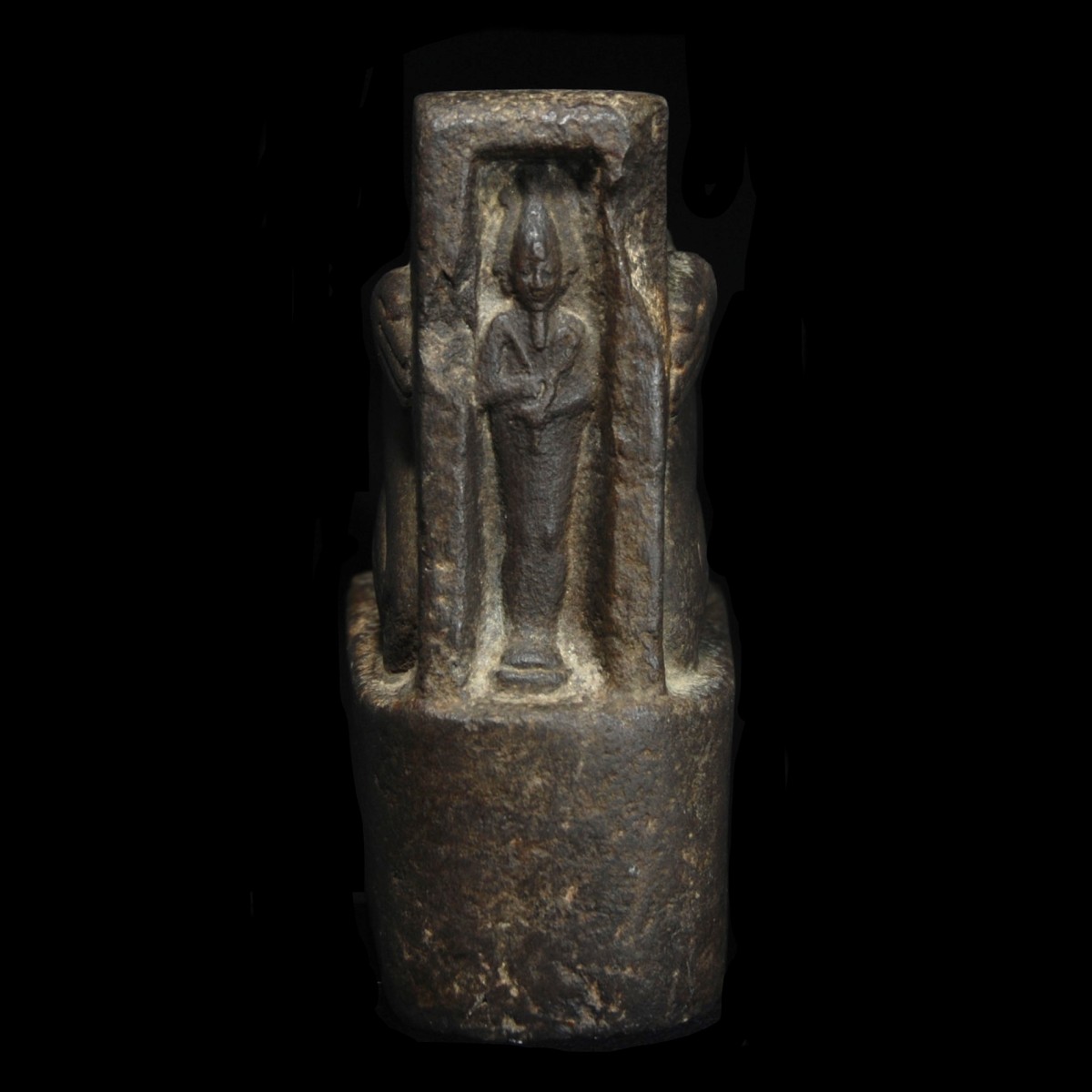
|
|
Egypt – Early 26th Dynasty, 664-600 B.C.
|
Massive fragment of a kneeling figure (naophorus) on a high base, holding with both arms a shrine (naos) before him. The naophorus with carefully formed hands and feet, the legs with accentuated muscles. A statuette of Osiris with an atef crown is standing inside the naos. The forehead is adorned with a uraeus snake, the royal cobra, the face is framed by a "false" beard of the gods. The arms crossed in front of the chest, in the left hand Osiris holds the crook, in the right the flail, both symbols of the absolute rule of the pharaohs.
|
Provenance: French private collection, acquired prior to 1973. Thence Christie's London on 1 October 2015, lot 154. Last with gallery Chenel in Paris. With a copy of the French antiquities passport.
Dimensions: 15.1 cm x 11.6 cm
Price: 12 000 Euro
|
|
|
|
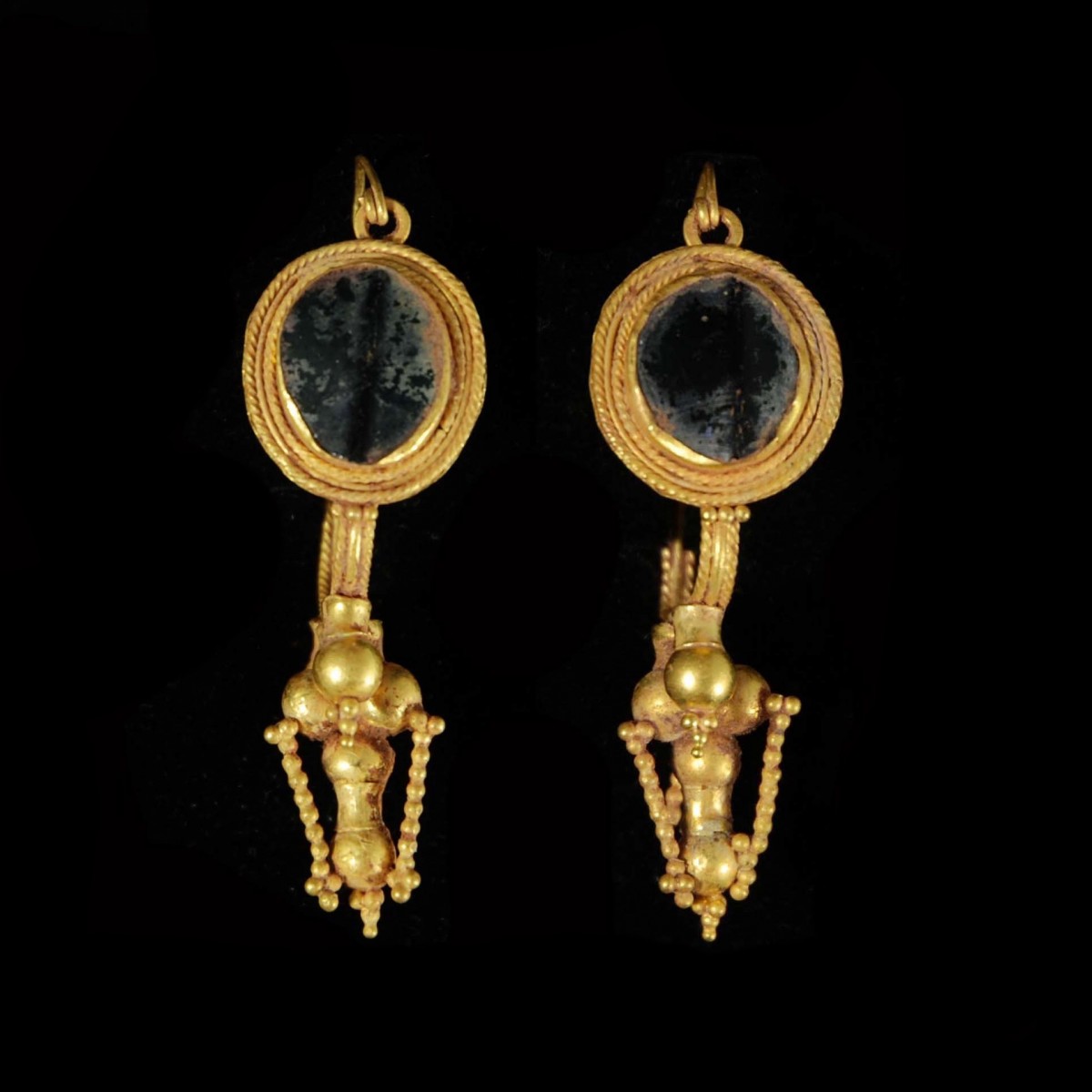
|
|
|
|
|
|
Roman Empire – 2nd century A.D.
|
Magnificent gold earrings with a dark red shimmering glass stone. The jewellery with a large clamp to which in front a twisted frame is attached where the glass stone sits. The frame at the top with an eyelet in which the clamp, which is made of two twisted and one smooth wire, hooks. Below seven small gold balls, some of which are connected with granules representing grape pendants. Exceptionally beautiful gold jewellery from the eastern part of the empire.
|
Provenance: Bavarian collection H. I. since the early 1970s.
Dimensions: each 5.8 cm high; 17.9 gram in total
Price: 4 000 Euro
|
|
|
|
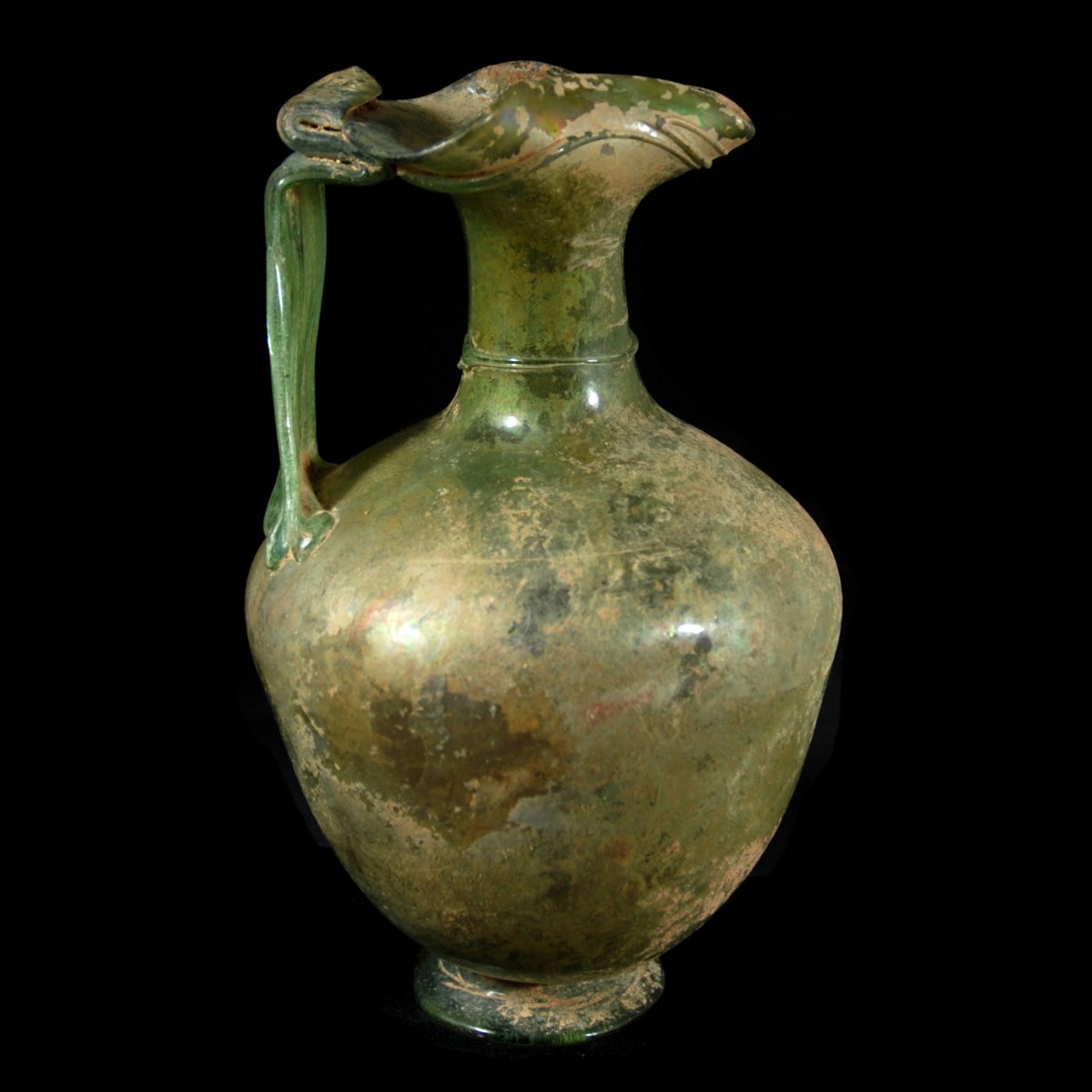
|
|
|
|
|
|
Roman Empire – 2nd-3rd century A.D.
|
Large flask of green clear glass with a trefoil spout. The oinochoe stands on a set off ring foot, the bulbous corpus with a flattened shoulder and a cylindrical neck. Around the neck and along the trefoil spout applied decorative threads. On the rear rim of the spout the ribbed handle starts, broadly tapering towards the shoulder.
|
Provenance: French private collection B., acquired in the 1960s. Thence Fraysee & Associes auction on 26 April 2014, lot 179. Accompanied by a French antiquities passport and an old collection photo.
Dimensions: 24 cm high
Price: 4 800 Euro
|
|
|
|
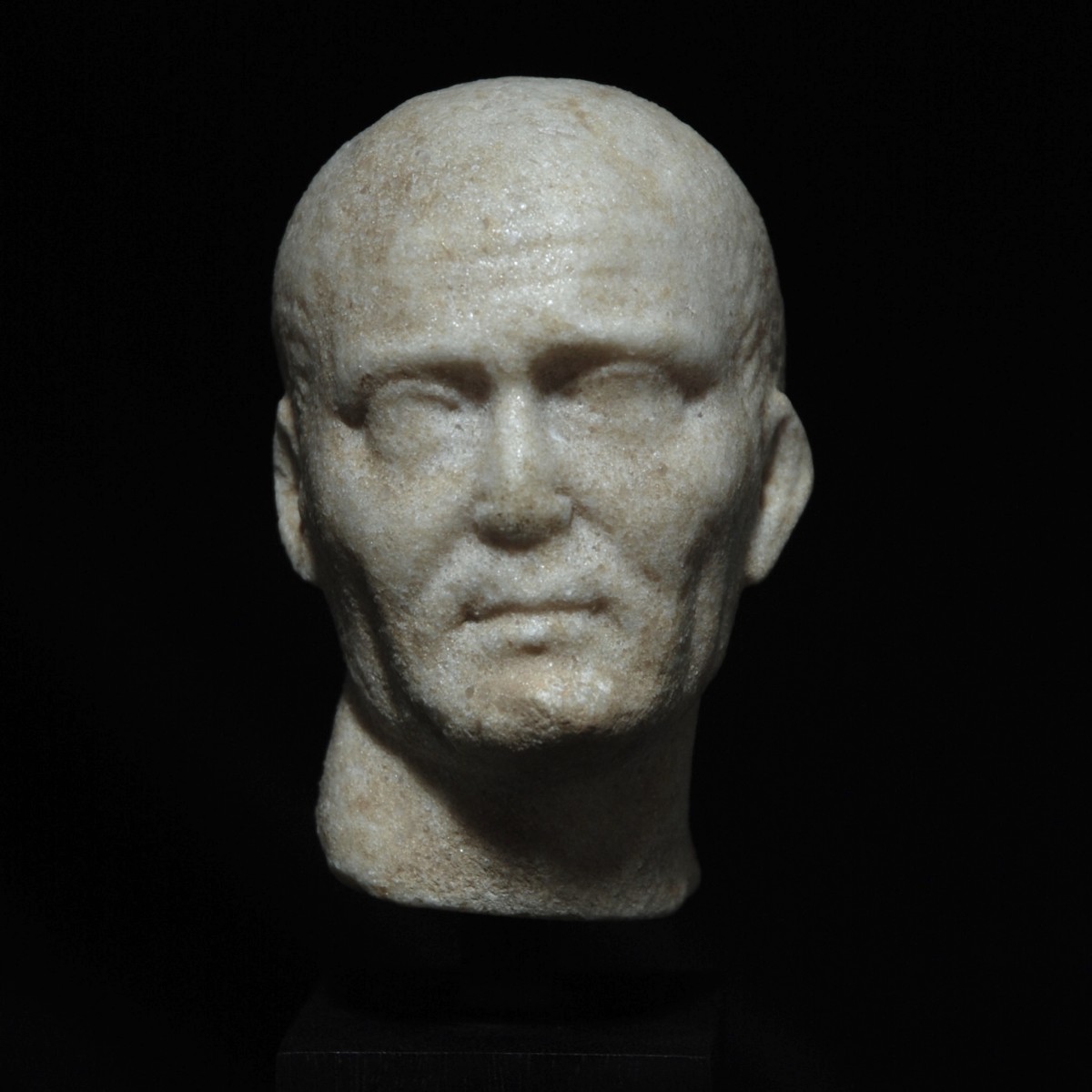
|
|
|
|
|
|
Roman Empire – 1st century B.C.
|
Small, but very-high quality character head from the Republican period. The middle-aged man with an angular face, prominent chin and deep cheek and nasolabial folds. The hair is shorn short. The head is slightly tilted to the right, the gaze is alert and directed straight ahead. The strong neck and prominent features indicate that this is a depiction of a man of determination, for sure of high rank. Mounted.
|
Provenance: From an old Parisian private collection, acquired at the Galerie de Serres in the early 1990s. Accompanied by a copy of the French antiquities passport.
Dimensions: 10.5 cm high
Price: 8 000 Euro
|
|
|
|
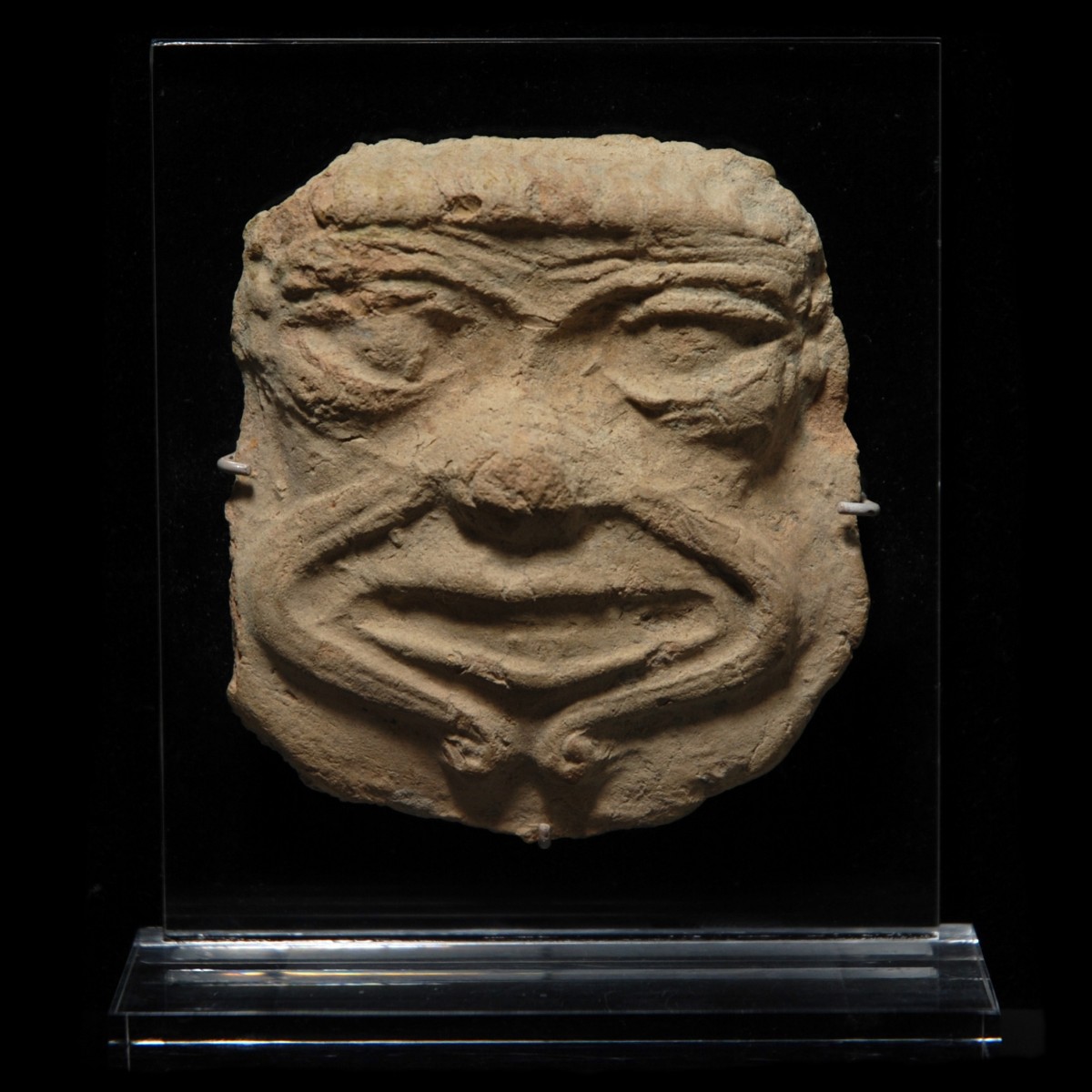
|
|
|
|
Sumer – 1st half of 2nd millennium B.C.
|
Light clay terracotta plaque depicting the demonic head of Humbaba. The guardian of the cedar forest was beheaded by Gilgamesh and his loyal friend Enkidu because they wanted to fell cedars in the forest of the goddess Inanna. As a demon, Humbaba had supernatural abilities, he was in possession of fears and was able to recognize his enemies from a great distance. Plaques like these were therefore used to keep evil away, but also to bring good luck to its owner. Humbaba has a broad nose, vigilant eyes set between strong eyelids and a wrinkled forehead with short, wavy strands of hair. The mouth is open to a broad grimace and reveals the rows of teeth. Typical of the depictions of the Humbaba from Mesopotamia is the long moustache, the strands framing the mouth and reaching down to the chin. The bartends are curled up. Mounted.
|
Provenance: Private collection Schlauf-Lensing, Germany. Thence Antikenkabinett Gackstätter with the inventory number 02270. There acquired on 18 June 2011 by the private collection Peter Hollander (1931-2014). With the original certificate by Bernd Gackstätter.
Dimensions: 7.4 cm x 6.9 cm
Price: 2 600 Euro
|
|
|
|

|
|
|
|
|
Large terracotta olpe with black-figured painting. The image area shows in a suggestive way the silhouette of two young men in long coats. Both have thrown the end of a coat around the arm, which is stretched forward. Ivy leaves on the rim. Egg-and-dart pattern, wavy band and ivy leaves on the neck. Ivy leaves also on the side. The handle starts in parallel from the rim and ends on the corpus. The reverse is glazed in black.
|
Provenance: English private collection between 1980 and 1990.
Dimensions: 25.5 cm high
Price: 2 800 Euro
|
|
|
|
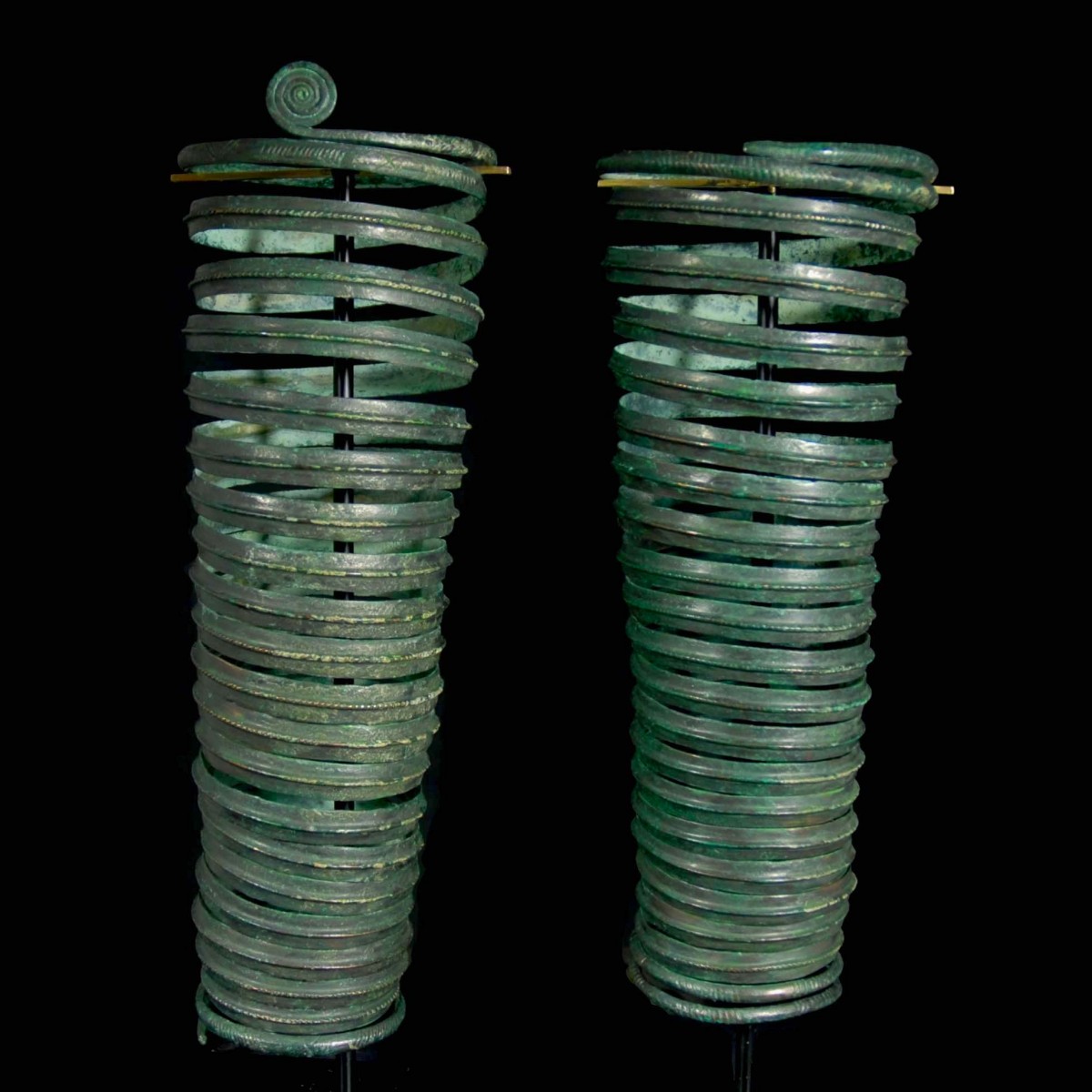
|
|
|
|
Middle Europe – 11th-10th century B.C.
|
A pair of large arm spirals made of bronze wire. The wire is flat inside and has outside, almost throughout, a raised midridge with engraved ribs. On the last two coils engraved line decoration. One of the two arm spirals has on top a transverse end spiral. From Central Europe. Mounted.
|
Provenance: English private collection Dr. N.
Dimensions: 28.4 cm and 24.4 cm high respectively
Price: 6 600 Euro
|
|
|
|
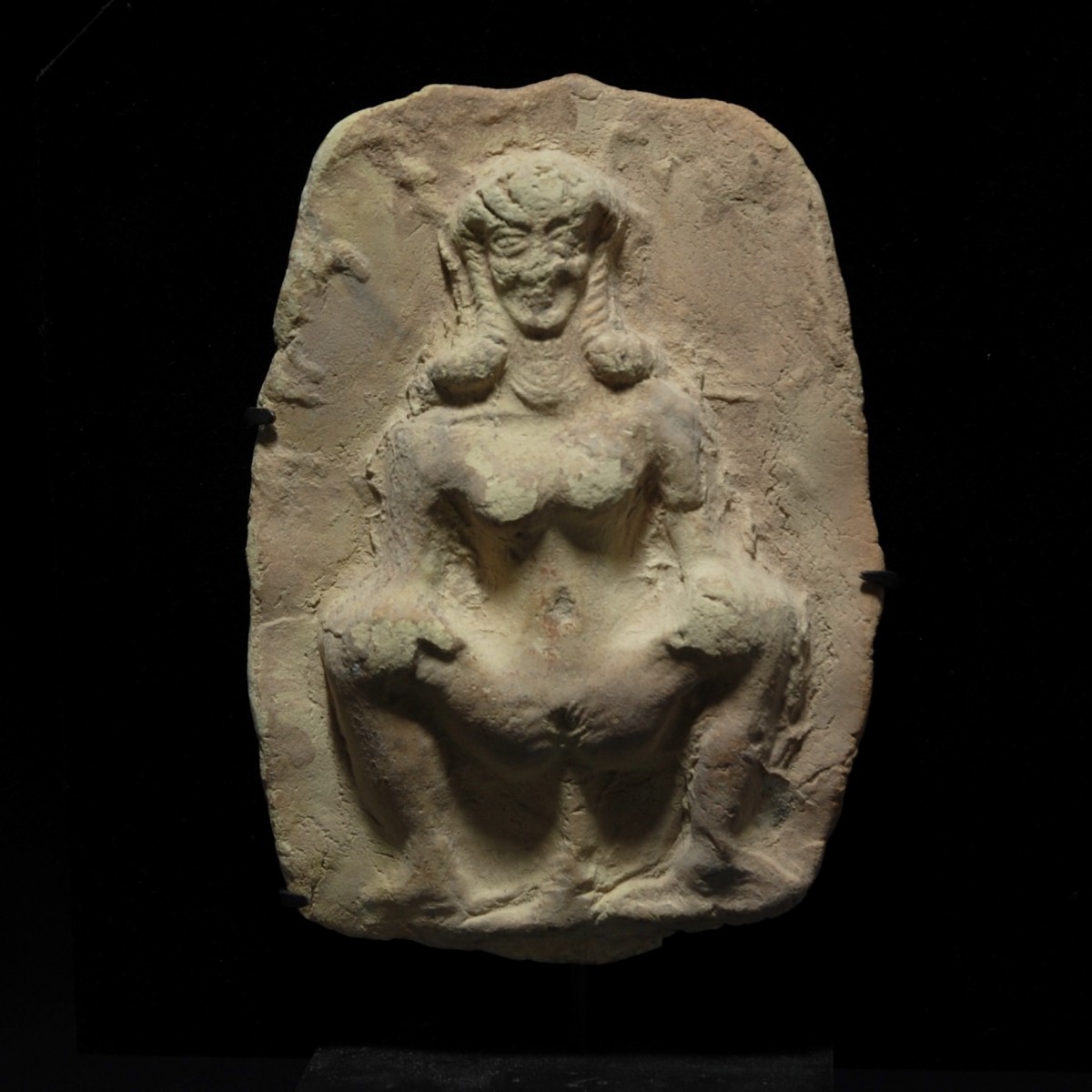
|
|
Sumer – 1st half of 2nd millennium B.C.
|
Explicit depiction of a crouching woman in frontal view with legs apart, who sits on a phallus. Her face with prominent features, her shoulder-length hair is braided. Apart from an opulent necklace, she is bare. Symplegma scenes like this probably served as votive offerings for a fertility cult. Similar plaques were found in Sippar-Amnanum. Mounted.
|
Provenance: From the estate of the New York collection Daryl P. Gruber-Kulok (1960-2019). Thence in a New York gallery.
Dimensions: 12.8 cm x 9.3 cm
Price: 2 200 Euro
|
|
|
|
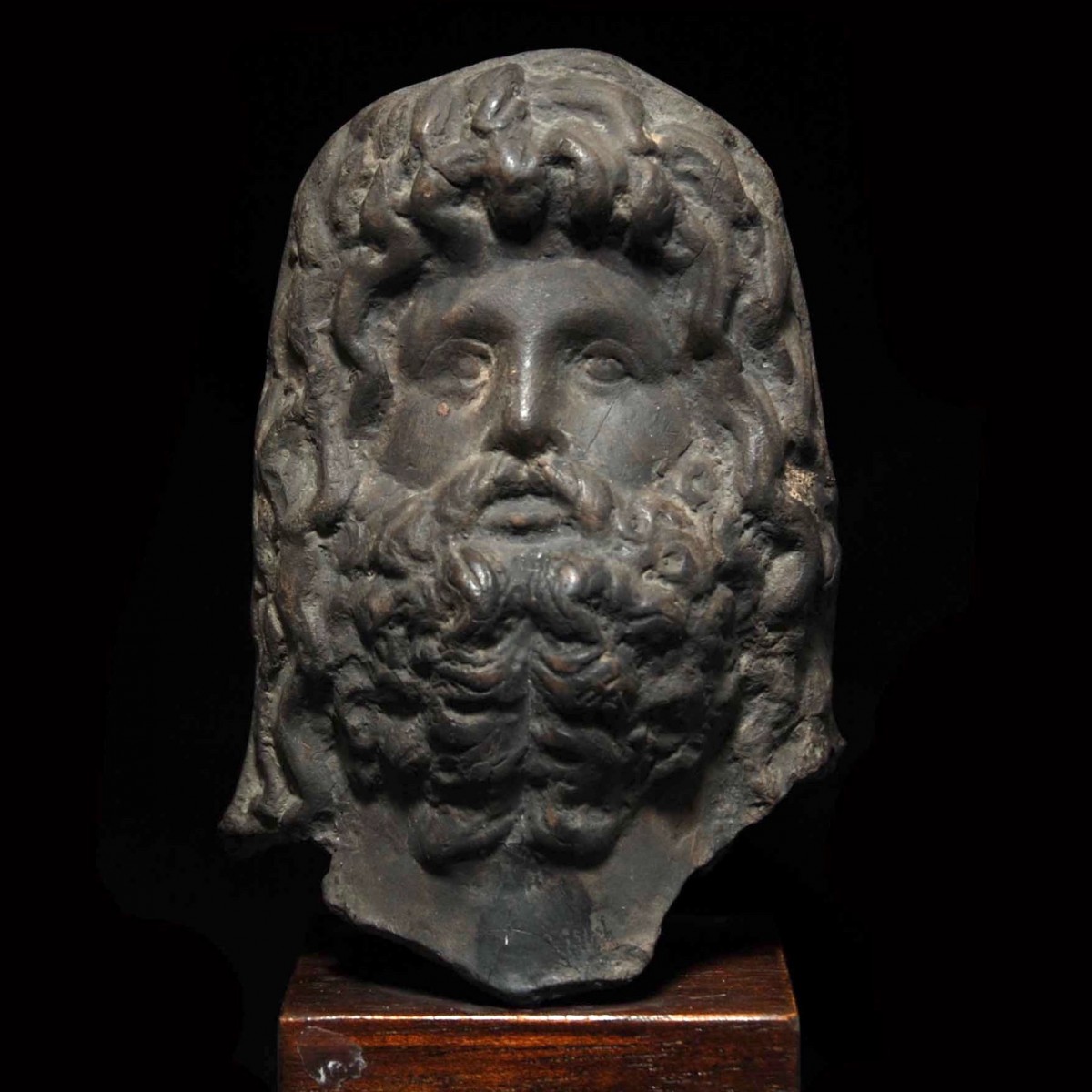
|
|
|
|
Egypt/Alexandria – 1st-2nd Century A.D.
|
Large head made of greyish dark, burnt clay of the syncretic god Serapis. The integrative imperial god, who was worshiped well into Roman times, with thick, long, curly hair and a full, also curly beard. The eyes are set deep, the mouth is slightly open. The hair at the back of the head is straight with curls cascading down the nape of the neck. From a workshop in Alexandria. The head is hollow inside and sits on an old wood base.
|
Provenance: French private collection Dr. Pierre Calvelli (1922-2015), acquired in the 1960s to the 1970s.
Dimensions: 13.2 cm high
Price: 2 800 Euro
|
|
|
|
|
|
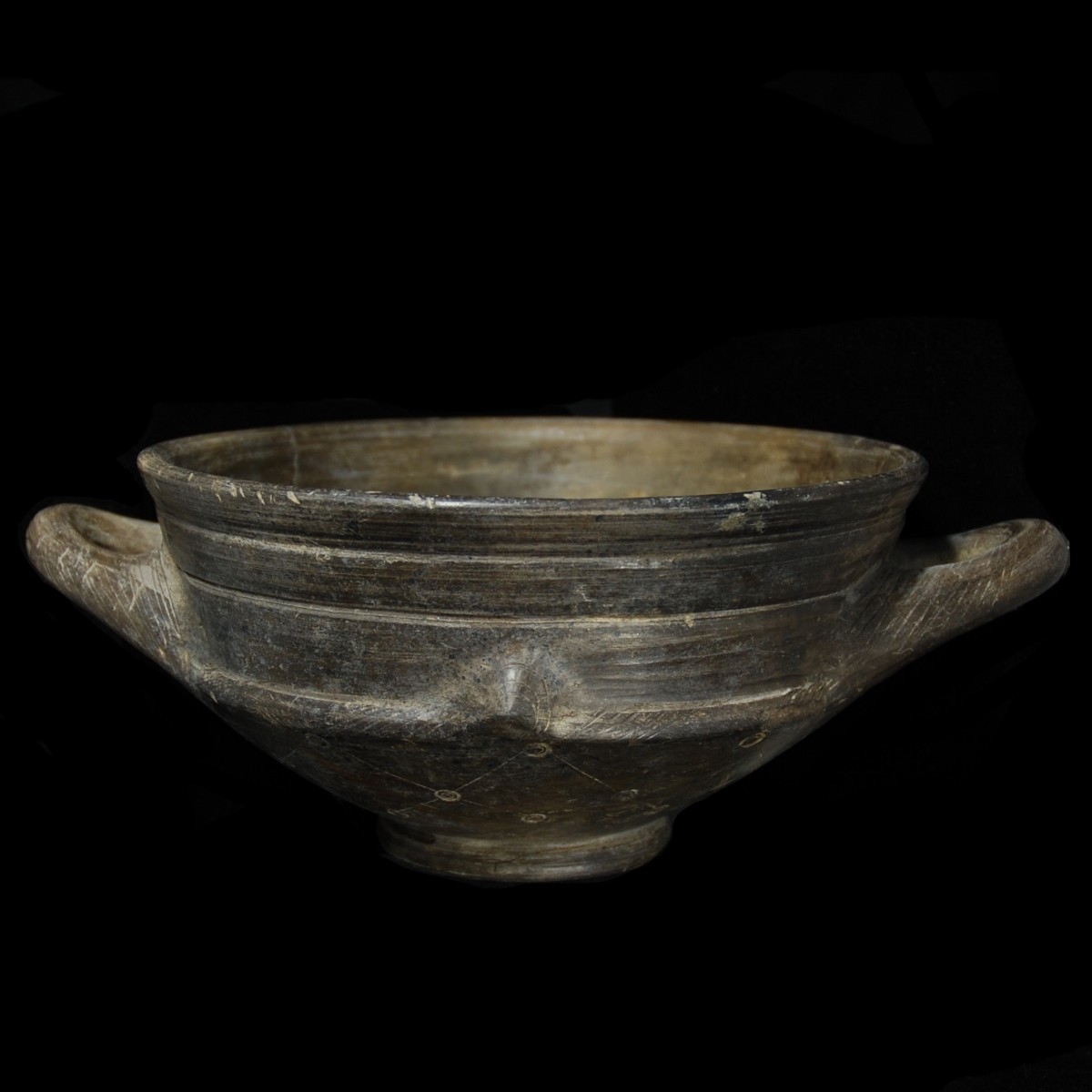
|
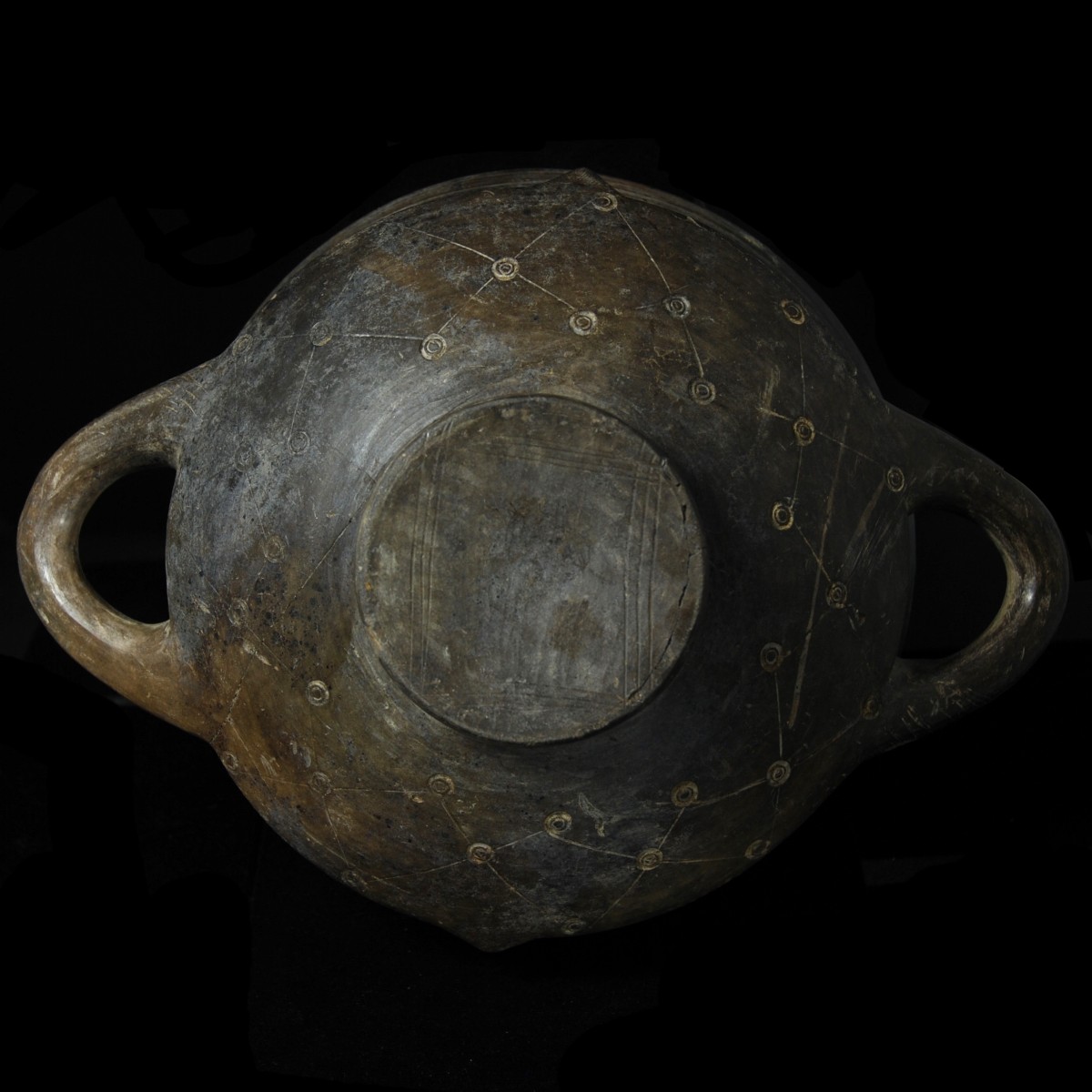
|
|
Etruria/Campania – 7th century B.C.
|
Large drinking bowl of the so-called Impasto ware made of brownish clay with a smooth, almost metallic, shiny surface. The bowl sits on a slightly offset, profiled ring base. The cup opens to about the middle of the body, where a set off, three-dimensional groove marks the transition to the neck. The neck with several gradations up to the protruding rim. The opposite handles are attached to the neck, both of which are decorated with fine incised hatching. At about the same height, two opposite, pointed studs are worked out of the wall, which are decorated with fine incised decoration. Also engravings all around the neck. The decoration at the bottom of the bowl is particularly elaborate. Here concentric circles were pressed into the clay, which are then connected with straight lines. A beautifully preserved, large vessel from the early Etruscans in Campania.
|
Provenance: Old Belgian private collection, then André Munter Archeologie, Brussels, Belgium. Acquired there on 14 August 2003 by another Belgian collection. With original certificate from André De Munter, Brussels. On the reverse of the certificate a sticker with the stamp of a court examination dated 26 June 2009 with the signature of the court clerk F. Coene N.
Dimensions: 27 cm in diameter
Price: 900 Euro
|
|
|
|
|
|
Wir bringen die Kunst der Antike
zu Ihnen nach Hause
|
|
Sollte Sie das eine oder andere Objekt begeistern, zögern Sie nicht, uns anzurufen +43/664 1168 324 oder uns zu schreiben info@cb-gallery.com. Gerne stehen wir auch per Videotelefonie jederzeit zur Verfügung und bearbeiten und beantworten jede Anfrage. Seien Sie auch versichert, dass der weltweite Versand mit DHL Express und Fedex Priority nach wie vor hervorragend funktioniert.
|
Am meisten jedoch freuen wir uns auf ein persönliches Wiedersehen mit Ihnen!
|
|
|
|
Unser Highlight des Monats:
|
|
Ägypten – Spätptolemäische Zeit, 1. Jahrhundert v. Chr.
|
Mumienmaske, die mit ihrer reichen Blattgoldverzierung, das goldene Fleisch der Götter symbolisiert, das identisch mit der Sonne Unsterblichkeit verheißt. Die Maske mit dreiteiliger Perücke und einem rot-blauen Stirnband, das hinten verschnürt ist. Auf der Stirn ein goldenes Udjat-Auge. Unter dem Diadem fallen blaue Strähnen in die Stirn, die in schwarzen Ringellocken auslaufen. Dominiert wird das Gesicht von den großen Augen mit den weit geöffneten, dunklen Pupillen, wie sie für die Masken aus dieser Zeit typisch sind. Darüber schwarz gezogene Brauen. Mund und Nase sorgfältig ausgearbeitet. Das goldene Gesicht ist von einer roten Linie eingerahmt. Auf den Perückenlappen kniende Göttinnen im Anbetungsgestus. Der Halskragen mit reich verziertem, polychromem Dekor. Die Maske unten mit einem Band von geometrischen Motiven verziert, den seitlichen Abschluss bilden Rosetten und Horusaugen. Auf der Rückseite eine stehende Frauenfigur nach rechts mit dreiteiliger Perücke und verschnürtem Diadem. Reste von Bitumen. Gesockelt.
|
Provenance: Belgische Privatsammlung, erworben in der Galerie des Saints-Pères in Paris im April 1980. Mit Kopie des Original-Zertifikats. Sotheby’s New York am 12. Dezember 2013, Los 18. Danach Sotheby’s Hongkong am 2. April 2018, Los 3047. Zuletzt Sammlung Chenel, Frankreich. Mit Kopie des französischen Antikenpasses.
Höhe: 46,5 cm
Price: 28.000 Euro
|
|
|
|
Ausgewählte Kunstwerke des Monats:
|
|
Etrurien – 350-300 v. Chr.
|
Prachtvolle Vollbronze-Darstellung einer stehenden Göttin im langen, faltenreichen Peplos. Sie steht mit ihrem Gewicht auf dem rechten Bein und hat das linke leicht nach vorne abgewinkelt. Der Peplos mit langem Überwurf wird durch zwei Broschen an den Schultern verschlossen. Die Göttin, möglicherweise erkennen wir hier eine der seltenen Darstellungen einer bekleideten Lasa (Begleiterin der Liebesgöttin Turan), hält in ihrer linken Hand ein großes Alabastron. Die rechte führt sie zu ihrem üppig aufgetürmten Haar, auf dem eine Bronze-Attasche sitzt. Diese Attasche zeigt rückseitig das Gesicht einer Gorgone und war auf einer Patera fixiert. Den gegenüberliegenden Abschluss bildeten die beiden Rosetten links und rechts über dem Kopf der Göttin. Die Statuette steht auf ihrer runden Original-Basis, die auf ihrer Außenseite mit Punkt- und Zungenmuster dekoriert ist. Vergleiche zum Typus einer unbekleideten Lasa mit ähnlicher Körperhaltung, Basis und Alabastron das Exemplar im J. Paul Getty Museum mit der Objektnummer 96.AC.34. Gesockelt.
|
Provenienz: Belgische Sammlung van der Aa, erworben von einer niederländischen Sammlung, 1960er Jahre. Danach Hirsch Auktion München 2016. Zuletzt im New Yorker Kunsthandel.
Höhe: 18.5 cm
Preis: 22.000 Euro
|
|
|
|
|
Ägypten – Anfang 26. Dynastie, 664-600 v. Chr.
|
Massives Fragment einer Kniefigur (Naophor) auf hoher Basis, die mit beiden Armen einen Schrein (Naos) vor sich hält. Der Naophor mit sorgfältig gearbeiteten Händen und Füßen, die Beine mit akzentuierter Muskulatur. Im Naos steht eine Statuette des Osiris mit Atefkrone. Die Stirn ziert eine Uräusschlange, die königliche Kobra, das Gesicht wird umrahmt von einem „falschen“ Götterbart. Die Arme liegen übereinander auf der Brust auf, in der linken Hand hält Osiris den Krummstab, in der rechten die Geißel, beides Symbole der absoluten Herrschaft der Pharaonen.
|
Provenienz: Französische Privatsammlung, erworben vor 1973. Danach Christie’s London am 1. Oktober 2015, Los 154. Zuletzt in der Galerie Chenel in Paris. Mit Kopie des französischen Antikenpasses.
Dimensionen: 15.1 cm x 11.6 cm
Preis: 12.000 Euro
|
|
|
|
|
Römisches Reich– 2. Jahrhundert n. Chr.
|
Prachtvolle Ohrringe aus Gold mit einem dunkelrot schimmernden Glasstein. Die Schmuckstücke mit einem großen Bügel an dem vorne eine tordierte Fassung angebracht ist, in der der Glasstein sitzt. Die Fassung oben mit Öse, in der der Bügel, der aus zwei tordierten und einem glatten Draht gearbeitet ist, einhakt. Unten sieben Goldkügelchen, die teilweise mit Granulaten verbunden sind und für Traubenanhänger stehen. Außerordentlich schöner Goldschmuck aus der östlichen Reichshälfte.
|
Provenienz: Bayrische Sammlung H. I. seit den frühen 1970er Jahren.
Dimensionen: Höhe je 5,8 cm; Gesamtgewicht 17,9 Gramm
Preis: 4.000 Euro
|
|
|
|
|
Römisches Reich – 2.-3. Jahrhundert n. Chr.
|
Große Flasche aus grünlichem Klarglas mit Kleeblattausguss. Die Oinochoe steht auf einem abgesetzten Ringfuß, der kugelige Körper mit abgeflachter Schulter und zylindrischem Hals. Um den Hals und entlang des Kleeblattausgusses aufgesetzte Zierfäden. Am hinteren Rand des Ausgusses setzt der gerippte Henkel an, der an der Schulter breit ausläuft.
|
Provenienz: Französische Privatsammlung B, erworben in den 1960er Jahren. Danach Fraysee & Associes Auktion vom 26. April 2014, Los 179. Mit französischem Antikenpass und altem Sammlungsfoto.
Höhe: 24 cm
Preis: 4.800 Euro
|
|
|
|
|
Römisches Reich – 1. Jahrhundert v. Chr.
|
Kleiner, sehr qualitätsvoll gearbeiteter Charakterkopf aus republikanischer Zeit. Der Mann mittleren Alters mit kantigem Gesicht, markantem Kinn und tiefen Wangen- sowie Nasolabialfalten. Die Haare sind kurz geschoren. Der Kopf ist leicht nach rechts geneigt, der Blick wach und geradeaus gerichtet. Der kräftige Hals und ausgeprägten Züge weisen darauf hin, dass wir es hier mit einem Mann von Entschlusskraft zu tun haben, jedenfalls von hohem Rang. Gesockelt.
|
Provenienz: Aus alter Pariser Privatsammlung, erworben Anfang der 1990er Jahre in der Galerie de Serres. Mit Kopie des französischen Antikenpasses.
Höhe: 10,5 cm
Preis: 8.000 Euro
|
|
|
|
|
Sumer – 1. Hälfte 2. Jahrtausend v. Chr.
|
Terrakotta-Plakette aus hellem Ton, die den dämonischen Kopf des Humbaba zeigt. Der Wächter des Zedernwaldes wurde von Gilgamesch und seinem treuen Freund Enkidu geköpft, weil diese im Wald der Göttin Inanna Zedern fällen wollten. Humbaba hatte als Dämon übernatürliche Fähigkeiten, er war im Besitz der Ängste und vermochte seine Feinde schon auf große Entfernung zu erkennen. Plaketten wie diese wurden daher verwendet, um das Böse fernzuhalten, aber auch um seinem Besitzer Glück zu bringen. Humbaba hat eine breite Nase, wache zwischen kräftigen Lidrändern sitzende Augen und eine faltige Stirn, über der kurze wellige Haarsträhnen liegen. Der Mund ist zur breiten Fratze geöffnet und lässt die Zahnreihen erkennen. Typisch für die Darstellungen des Humbaba aus Mesopotamien ist der lange Schnauzbart, dessen Strähnen den Mund einrahmen und bis zum Kinn reichen. Die Bartenden sind eingerollt. Gesockelt.
|
Provenienz: Privatsammlung Schlauf-Lensing, Deutschland. Danach bei Antikenkabinett Gackstätter mit der Inventarnummer 02270. Dort erworben am 18. Juni 2001 von der Privatsammlung Peter Hollander (1931-2014). Mit Original-Zertifikat von Bernd Gackstätter.
Dimensionen: 7.4 cm x 6.9 cm
Preis: 2.600 Euro
|
|
|
|
|
Etrurien – 490-470 v. Chr.
|
Große Terrakotta-Olpe mit schwarzfiguriger Malerei. Die Bildfläche zeigt in durchaus pikanter Weise die Silhouette von zwei jungen Männern in langen Mänteln. Beide haben ein Mantelende um den nachvorne gestreckten Arm geworfen. Am Rand Efeublätter. Am Hals Eierstabmuster, Wellenband und Efeublätter. Seitlich ebenfalls Efeublätter. Der Henkel geht parallel vom Rand ab und setzt am Korpus wieder an. Die Rückseite schwarz glasiert.
|
Provenienz: Englische Privatsammlung zwischen 1980 und 1990.
Höhe: 25.5 cm
Preis: 2.800 Euro
|
|
|
|
|
Mitteleuropa – 11.-10. Jahrhundert v. Chr.
|
Ein Paar großer Armspiralen aus innen flachem Bronzedraht. Außen fast durchgängig ein Mittelgrat mit gravierten Rippen. An den letzten beiden Windungen jeweils graviertes Strichdekor. Eine der beiden Armspiralen hat oben eine quergestellte Endspirale. Aus Mitteleuropa. Gesockelt.
|
Provenienz: Englische Privatsammlung Dr. N.
Höhe: 28,4 cm und 24,4 cm
Price: 6.600 Euro
|
|
|
|
|
Sumer – 1. Hälfte 2. Jahrtausend v. Chr.
|
Explizite Darstellung einer hockenden Frau in Frontalansicht mit gespreizten Beinen, die sich auf ein männliches Geschlecht setzt. Das Gesicht mit ausgeprägten Zügen, das Haar schulterlang und geflochten. Abgesehen von üppigem Halsschmuck ist sie unbekleidet. Symplegma-Szenen wie diese dienten wohl als Votivgaben für einen Fruchtbarkeitskult. Vergleichbare Plaketten wurden in Sippar-Amnanum gefunden. Gesockelt.
|
Provenienz: Aus dem Nachlass des New Yorker Sammlers Daryl P. Gruber-Kulok (1960-2019). Danach in einer New Yorker Galerie.
Dimensionen: 12,8 cm x 9,3 cm
Preis: 2.200 Euro
|
|
|
|
|
Ägypten/Alexandria – 1.-2. Jahrhundert n. Chr.
|
Großer Kopf aus gräulich dunklem, gebranntem Ton des synkretistischen Gottes Serapis. Der integrative Reichsgott, der bis weit in römische Zeit verehrt wurde, mit dichten langen gelockten Haaren und einem vollen, ebenfalls gelockten Bart. Die Augen sitzen tief, der Mund ist leicht geöffnet. Das Haar am Hinterkopf glatt mit im Nacken auslaufenden Locken. Aus einer Werkstatt in Alexandria. Der Kopf ist innen hohl und sitzt auf einem altem Holzsockel.
|
Provenienz: Französische Privatsammlung Dr. Pierre Calvelli (1922-2015), erworben in den 1960er bis 1970er Jahren.
Höhe: 13,2 cm
Price: 2 800 Euro
|
|
|
|
|
Etrurien/Kampanien – 7. Jahrhundert v. Chr.
|
Große Trinkschale der so genannten Impasto Ware aus bräunlichem Ton mit glatter, beinahe metallisch glänzender Oberfläche. Die Schale sitzt auf einem leicht abgesetzten, profilierten Ringfuß. Die Schale öffnet sich etwa bis zur Mitte des Korpus, wo eine abgesetzte, plastische Rille den Übergang zum Hals markiert. Der Hals mit mehreren Abstufungen bis zum ausladenden Rand. Am Hals setzen auch die gegenüberliegenden Henkel an, die beide mit feinen Ritz-Schraffierungen verziert sind. In etwa gleicher Höhe sind zwei gegenüberliegende, zugespitze Buckel aus der Wandung gearbeitet, die mit feinem Ritzdekor verziert sind. Am Hals umlaufend ebenfalls Ritzungen. Besonders aufwändig ist die Verzierung auf der Unterseite der Schale. Hier wurden konzentrische Kreise in den Ton gedrückt, die anschließend mit geraden Linien verbunden sind. Ein schön erhaltenes, großes Gefäß der frühen Etrusker in Kampanien.
|
Provenienz: Alte belgische Privatsammung, danach André Munter Archeologie, Brüssel. Dort erworben am 14. August 2003 von einer anderen belgischen Sammlung. Mit Original-Zertifikat von André De Munter, Brüssel. Auf der Rückseite des Zertifikats ein Aufkleber mit Stempel einer Gerichtsbeschau vom 26. Juni 2009 mit der Unterschrift des Gerichtsschreibers F. Coene N.
Durchmesser: 27 cm
Preis: 900 Euro
|
|
|
|
|
|
|
CHRISTOPH BACHER ARCHÄOLOGIE ANCIENT ART GmbH
|
Galerie: Stubenring 20, A-1010 Wien
Showroom: Untere Viaduktgasse 55, A-1030 Wien
|
|
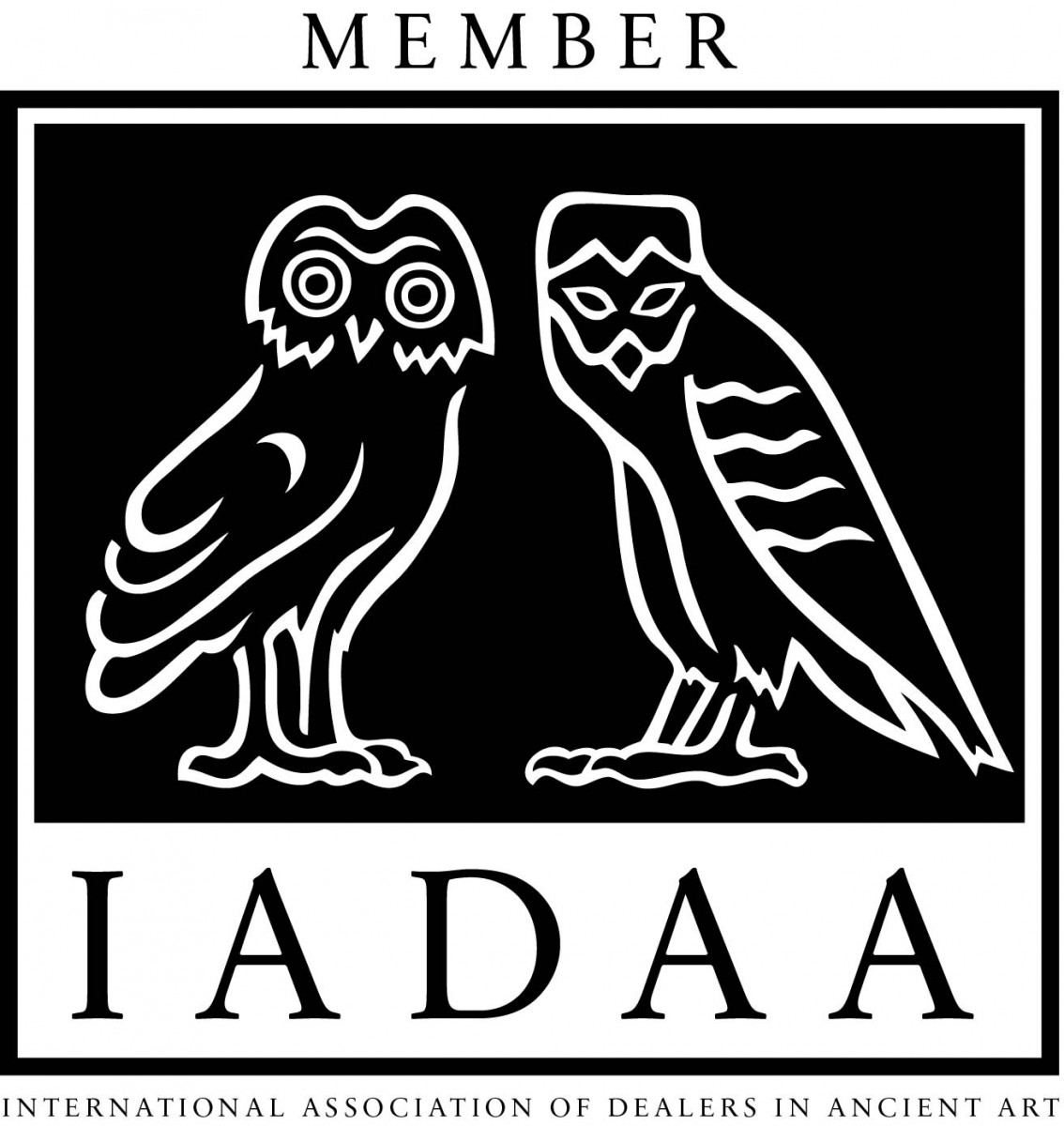
|
|
|
|